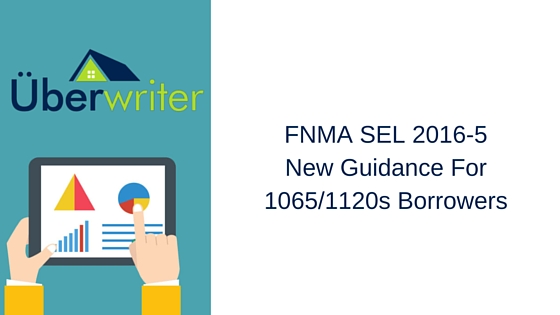One of the most common topics I run across for self-employed borrowers is the discussion on ”The dreaded Distribution Versus Ordinary Income”. Even though the guidelines clearly outlined these requirements for years, they never seemed to be enforced. The guidelines were largely ignored by lenders selling to both agencies. Since FNMA has brought the distribution of business income back, as an industry I think we are still a little “wobbly legged” over the requirements. To help get us back on our feet, over the last twelve to eighteen months FNMA has slightly modified the guidance to help the industry adopt and understand the distribution concept .
SEL 2016-05 Changes
On June 28th FNMA with SEL 2016-05 has tweaked and clarified the guidelines again to assist lenders with how to evaluate if the borrower had actually received the business income from a partnership (1065 tax form), S Corporation (1120S), or an LLC (1065 Tax Form) .
First FNMA has now eliminated the need to provide a partnership agreement or corporate resolution to support “access to income”. I really applaud this move because reviewing these documents really did not clear up anything, and most of the time just generated more confusion.
Second FNMA has endorsed a more numbers based approach to evaluate the ability for a company to distribute income. NOTE these ratios are only needed if the borrowers K-1’s doesn’t show distribution of income that supports your K-1’s and cash flow adjustments.
Here is some of the new guidance from AllRegs:
B3-3.2.2-01: Analyzing Partnership Returns for a Partnership or LLC (06/28/2016)
The lender may use discretion in selecting the method to confirm that the business has adequate liquidity to support the withdrawal of earnings. When business tax returns are provided, for example, the lender may calculate a ratio using a generally accepted formula that measures business liquidity by deriving the proportion of current assets available to meet current liabilities.
The Quick Ratio (also known as the Acid Test Ratio) is appropriate for businesses that rely heavily on inventory to generate income. This test excludes inventory from current assets in calculating the proportion of current assets available to meet current liabilities.
The Current Ratio (also known as the Working Capital Ratio) may be more appropriate for businesses not relying on inventory to generate income.
For either ratio, a result of one or greater is generally sufficient to confirm adequate business liquidity to support the withdrawal of earnings.
End quotes from FNMA AllRegs
Using the new guidance, we created the following examples of the formulas using the current 2015 tax forms to source the location of each line needed to follow the math provided by FNMA. Keep in mind the entire purpose of this test is to answer one question. “Was the business able to distribute the income?”


Hopefully that puts FNMA SEL 2016-05 in a bit more context for you. For next week’s blog lest discuss this math a little further, FNMA updating their guidelines with this information was very helpful, but let’s break down the schedule L a little further and see if we can maybe more accurately find out if a business is solvent.


7 Responses
Great information Michael thank you!
Awesome info as usual. Thank you Michael.
Very helpful information which I had not previously seen. Thank you Michael.
Thanks Kimberly, we appreciate the comment and thank you and first bank for being loyal customers!
Wouldn’t using the total assets on line 15/14/D divided by total liabilities and shareholder equity on line 27/22D of the Schedule L always result in a factor of 1? Since Sch. L is essentially a balance sheet, the totals on the lines you mention are required to be identical, a.k.a “balance.” Are they not? A quick ratio or a current ratio would involve use of “current” liabilities and assets. In accounting terms, “current” means assets or liabilities due/convertible to cash in 1 year or less. I believe this is lines 1, 2, and 3 and 16, 17 and 18 of the schedule L on both form 1065 and 1120S.
How to review the business bank statement when proofing the adequate liquidity? For example, ordinary income is $12,000 with no distribution for the past two years and business is 100% own, should the business bank statement support min balance of $1,000 on most recent three months bank statements or $12,000 min balance is all three months? Please help and I’m confused about this. Thank you!
Hi Dara
We have some great training videos on the subject included with your subscription to UberWriter, that will give full detail. The short answer is business solvency is determined by looking at the SCH L form for the business and reviewing the assets vs liabilities to show the business is solvent. It does not matter what is in the checking account now, it matters what they had at year end on the SCH L to support that they COULD have paid the distributions but did not!
Thanks!